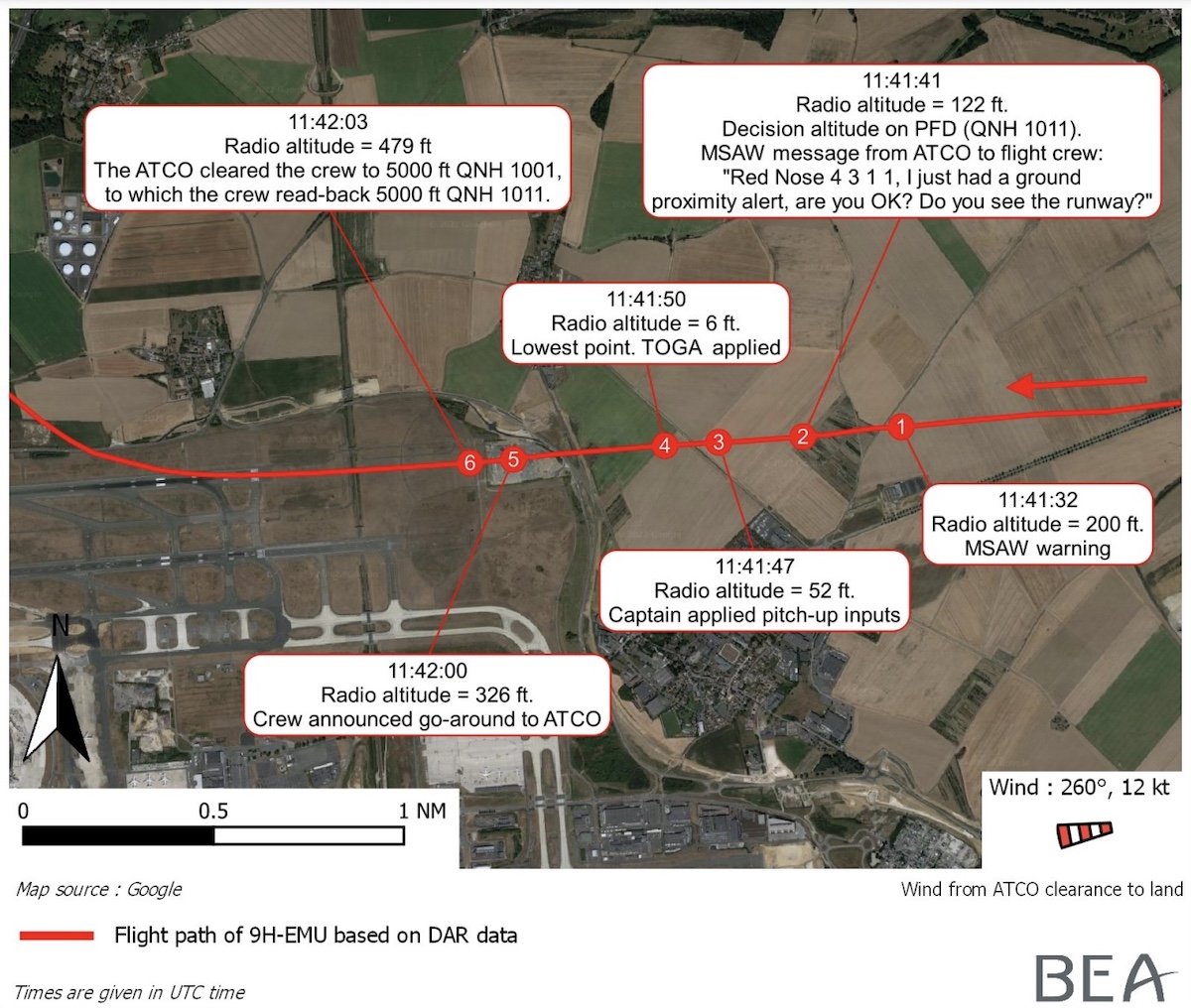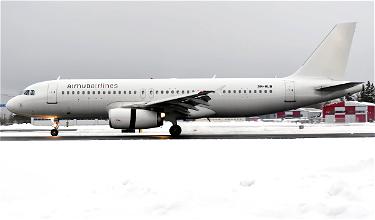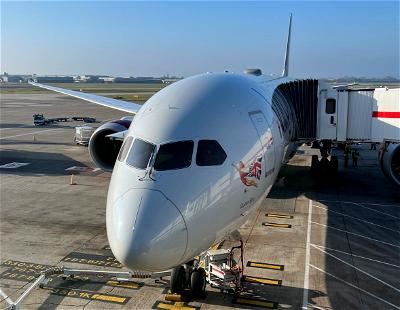France’s Bureau of Enquiry and Analysis for Civil Aviation Safety (BEA) has just released its preliminary report about an incident that happened in late May, and it’s kind of terrifying. As noted by @AirlineFlyer, a plane with 172 passengers onboard was within six feet of crashing.
In this post:
Incorrect altimeter setting leads to near disaster
This incident involves a flight on May 23, 2022, from Stockholm (ARN) to Paris (CDG). The flight was operated by a 23-year-old Malta-based Airhub Airbus A320 with the registration code 9H-EMU. The plane was operating under a wet lease agreement for Norwegian Air, and was carrying 178 people, including six crew members and 172 passengers.
The flight operated totally as scheduled until the approach. The weather wasn’t great in Paris, and the crew claims that they were in the clouds for the entire approach, and experienced moderate turbulence. That shouldn’t be an issue, since the pilots performed an RNP approach, which is highly automated and follows the glidepath. That’s the beauty of modern aviation.
The issue is that executing this kind of landing requires computers being programmed correctly, and this is where the issues started. Pilots need to set the correct altimeter, which is a measure of altitude based on air pressure.
Air traffic controllers will often remind pilots of the altimeter, but in this case the air traffic controller gave the pilots the wrong altimeter multiple times — rather than providing an altimeter of 1001, the controller provided an altimeter of 1011. The difference of 10 hPa would lead to an approach being carried out 280 feet too low.
Here’s the transcript of the ATC audio (“Red Nose” is the Norwegian callsign):
Controller: “Red Nose 4311, descend… descend 6,000 feet, 1011.”
Pilot: “6,000 feet, 1011… 1011, Red Nose 4311”
Controller: “Red Nose 4311, descend 5,000 feet, 1011, cleared full RNP 27R.”
Pilot: “Descend 5,000 feet, QNH 1011, cleared full RNP approach 27R, Red Nose 4311.”
Now, it’s worth noting that while there are other sources for getting the altimeter (like a METAR or ATIS), the company’s manual didn’t require that to be cross checked, since you’d expect the controller to give you the correct information. After all, an air traffic controller’s primary job is providing accurate information to pilots.
It’s worth noting that an EasyJet plane landing around the same time had the following interaction:
Controller: “Easy 75 Mike Alpha direct Papa Golf 650, and descend 5,000 feet, 1011, cleared RNP approach 27R.”
Pilot: “Direct to Papa Golf 650, descend 5,000 feet, QNH 1001, Easy 75.”
Funny enough, the EasyJet pilots read back the correct altimeter, without acknowledging it with the controller. Presumably they thought the controller was just making an obvious mistake. Meanwhile in another interaction, the controller gave Air France pilots the correct value, but that was in French and not English.
Anyway, back to the flight in question. On the final approach, the Minimum Safe Altitude Warning (MSAW) was triggered in the cockpit, and shortly thereafter the air traffic controllers received a ground proximity alert, so checked on the pilots.
Finally 0.8 nautical miles from the end of the runway, and at a recorded altitude of six feet above the ground, the pilots finally performed a go around. That’s right, the plane was six feet from the ground, and there was still a road between the plane and the runway, so imagine how that could have ended. You can see this all in the diagram below.
With the plane having been six feet off the ground, it’s safe to say they were literally one second from disaster.

Then there was a second approach…
The pilots attempted a second approach after performing a go around. The issue is that they still didn’t realize that they had the wrong altimeter, so they once again started their approach 280 feet too low.
As the pilots were on approach, they asked the controller if the approach lights were on (since they couldn’t see them), and the controller confirmed that they were. The Minimum Safe Altitude Warning (MSAW) was once again triggered on this approach. The controllers also got a terrain alert again, and informed the pilots.
The only thing that was different this time around is that the cloud coverage wasn’t quite as bad, so the pilots could perform a visual approach, and could correct that they were too low.
Bottom line
Aviation is incredibly safe, and is actually the safest form of transportation. For every disaster that actually happens, there are a countless number of near disasters. In this case an Airbus A320 was just six feet from crashing into the ground due to having the incorrect altimeter — I don’t think it gets much closer than that.
This incident happened because the air traffic controller in Paris repeatedly gave pilots the incorrect altimeter, making the pilots believe they were 280 feet higher than they actually were. With limited visibility, that can be the difference between life and death. Whether or not pilots have any responsibility here is above my pay grade…
What do you make of this incident?
(Featured image courtesy of Anna Zvereva)





The radio altimeter would have have issued verbal indications that the aircraft was lower than thought. Those callouts might be just mildly confusing at 1000 and 500, but when the rapid annunciation of 50-40-30-20-retard began, within nothing in sight, a missed approach would have been in order. Not sure why this cue did not prompt a go around much sooner than 6’ agl.
Pilot should listen to ATIS n any big diff like this must be reconfirm n advise the controller of the big difference. Futhermore when low cloud is present, it must be low pressure condition not a condition of pressure close to ISA std. Also when close to ground (below 2500 ft) check the Radio Altimeter height with the baro Altimeter- elevation.
Giving reason that “not in company Manual’ to check n follow ATIS is...
Pilot should listen to ATIS n any big diff like this must be reconfirm n advise the controller of the big difference. Futhermore when low cloud is present, it must be low pressure condition not a condition of pressure close to ISA std. Also when close to ground (below 2500 ft) check the Radio Altimeter height with the baro Altimeter- elevation.
Giving reason that “not in company Manual’ to check n follow ATIS is such a lame excuse and that is not the way to think as a Professional Aviator. This is PPL standard of thinking. Please accept your mistake and learn. Its your life n the passengers NOT the controller’s life !!.
Norwegian Airline shd be more vigilant in when awarding wet lease to any company.
Pilot should listen to ATIS n any big diff loke this must be recomfirm n advise the controller of the big different. Futhermore when low cloud is present, it must be low pressure condition not a condition of pressure close to ISA std. Also when close to ground (below 2500 ft) check the Radio Altimeter height with the baro Altimeter- elevation.
Giving reason that “not in company Manual’ to check n follow ATIS is...
Pilot should listen to ATIS n any big diff loke this must be recomfirm n advise the controller of the big different. Futhermore when low cloud is present, it must be low pressure condition not a condition of pressure close to ISA std. Also when close to ground (below 2500 ft) check the Radio Altimeter height with the baro Altimeter- elevation.
Giving reason that “not in company Manual’ to check n follow ATIS is such a lame excuse and that is not the way to think as a Proffesional Aviator. This is PPL standard of thinking. Please accept your mistake and learn. Its your life n passenger NOT the controller life !!.
Norweigion Airline shd be more vigilant in when awarding wet lease to any company.
Can we remove the "human" from this yet?
Humans are very bad at doing repetitive tasks.
The EasyJet incorrect read back is another huge overlooked problem. Those pilots should be grounded too.
So you are volunteering to occupy the first pilotless passenger aircraft? Excellent! Comments such as yours demonstrate the need to further Darwin’s concept of “Natural Selection!”
Roger one-fourteen, this is Dulles Tower. We have radar contact and show you on ILS. You're in the glide path and looking good.
Yippee Ki Yay
This doesn't make any sense. Below 2000ft, the radio altimeter is used and the baro setting has no influence whatsoever on the RA readings. Also baro setting has no influence on the ILS.
Realise that they were in fact flying an RNP approach. Not an ILS
In Diagram they are clear to 5000 feet , but are at 500 feet ( Radio-altimeter ) Way off Glide-slope , location on radar, GPS altitude , Airplane ground proximity warning systems etc. There are lots of questions here not related to wrong altimeter setting on airplane.
When they are cleared to 5000 feet they are in the go-around following the Missed Approach Procedure. Thus, they are cleared to climb to 5000 feet to initiate their next approach.
Just FYI this is die hard 2 situation
The issue is, that they Mix Up French with English, and their english competence is low. Remember the dialog in JFK with the ITA issue? A friend, ATC Controller in Germany answered on my question, which Airline he consider as unsafe: Turkish and Air France... I don't travel with AF and try to stay away fein CDG!
I’d have pilots and tower drug tested. Stupid, careless on both sides.
This is where pilot experience and strong backup procedures keep some situations from getting back at larger airlines. Since this flight involved a second or third tier airline operating the flight, the chances are that the pilots were not near as experienced to know what was wrong not just the first time but even on the secnd approach
With the pilot shortage and rapid hires at even the big legacy / flag carriers let's hope that experience is somehow replicated via training in place though wondering how training can replace the experience of senior pilots.
It's not 2010 with only the most senior pilots flying around for the big US carriers post the great recession layoffs.
Would also add are we better off having some somewhat older pilots by extending retirement age to maintain that seasoning at least while new crews ramp
I heard they were former Delta pilots.
While I don’t want to play armchair quarterback on what happened, I think it‘s hard to fault the pilots for what happened. If ATC gives a different altimeter setting than what’s on the ATIS/METAR, pilots usually believe ATC has updated information, especially if the ATIS was somewhat older, and will plug it in. ATC has screens available with current weather info at fields they are controlling, and so when they advise of an altimeter setting,...
While I don’t want to play armchair quarterback on what happened, I think it‘s hard to fault the pilots for what happened. If ATC gives a different altimeter setting than what’s on the ATIS/METAR, pilots usually believe ATC has updated information, especially if the ATIS was somewhat older, and will plug it in. ATC has screens available with current weather info at fields they are controlling, and so when they advise of an altimeter setting, pilots will think it’s being read straight from the current weather report and is the most up to date source of information.
Agree that I mostly blame ATC on this. The one thing I'd think the pilots could've done is double-check the METAR. 1011 and 1001 is a big difference so they would've noticed that and could've asked for clarification.
But unless the Radio Altimeter was on deferral how do you fly at 6' AGL? On top of that, how do you do an RNP approach where the weather still has you "in the clouds" at 6' AGL. That seems to be well below minimums for an RNP approach. Then they are visual on the second approach? Something isn't adding up or my brain just isn't function tonight.
“Meanwhile in another interaction, the controller gave Air France pilots the correct value, but that was in French and not English.”
It’s pretty difficult to give numbers correctly in French, but wrong numbers in English. Like, “zero” is “zero” in both languages with minor pronunciation differences..
I wonder how they pronounced 1001 and 1011. In other words, did they say "one-thousand-and-one" or "one-zero-zero-one" or "ten-oh-one" or any other variation. This might account for the differences between languages.
The altimeter setting is almost always read character by character - so in this case one zero one one. Exceptions might be numbers like 1000
wonder why the audio “too low terrain” warnings which I assume were blurting out in the cockpit were being ignored, unless of course the pilots hit the master alarm silence switch as part of a RNP approach?
Usually on an approach the GPWS is automatically off since the aircraft recognizes it’s about to land on a given runway. From my understanding, an RNP approach gives a calculated approach path based off the flight computer’s information about an aircraft’s path, which feeding an incorrect altimeter setting would throw that off and cause the aircraft to think it’s fine when it’s truly not.
All I can think about is Die Hard 2.
Wow - surprised that being 10 feet off on runway altitude would mean reaching 0 above ground level a whole mile away from the runway
They were 280 feet too low, not 10 feet. The altimeter setting appears to have been 10 millibars off.
Ah got it thanks